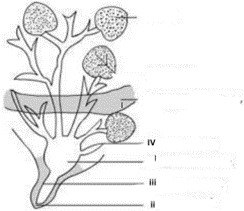The background below illustrates an organ of a farm animal. Use it to answer the question below.

This synthesis of milk occurs in the part labeled
I
II
III
IV
Correct answer is B
No explanation has been provided for this answer.
The partitioning of pasture into convenient units for good grazing management is known as
Pastoralism
Ranching
Paddocking
Grazing
Correct answer is C
No explanation has been provided for this answer.
Farm animals that could graze on rangeland include
Cattle, pig and sheep
Turkey, rabbit and pig
Rabbit, turkey and goat
Goat, cattle and sheep
Correct answer is D
No explanation has been provided for this answer.
Which of the following plants is not a forage legume?
Andropogon gayamus
Mucuna utilis
Calopogonium mucunoides
Centrosema molle
Correct answer is A
No explanation has been provided for this answer.
The term ad libitum as used in animal production refers to
Reduction in feed supply during the dry season
Restriction of water to animals
Addition of supplements to feed and water
Availability of feed and water at all times
Correct answer is D
No explanation has been provided for this answer.
During digestion in farm animals, the production of volatile fatty acids occur in
Chicken
Duck
Sheep
Pig
Correct answer is C
No explanation has been provided for this answer.
Blood stain diarrhea in poultry is a symptom of
Newcastle disease
Avian influenza
Coccidiosis
Marck's disease
Correct answer is C
No explanation has been provided for this answer.
Sub-categories
Aptitude Tests
Latest Jobs
Laboratory Assistant at New Material Nigeria Company Limited
Pastry Chef at Quality Foods Africa
HSE Supervisor at CWAY Nigeria Limited
Finance Assistant at the Centre for Law Enforcement and Education (CLEEN) Foundation
Sports Marketing Manager at Red Bull
Personal Assistant to Managing Director at Engee PET Manufacturing Company Nigeria Limited
Facility Manager at Nestoil Limited
Secretary at Golden Oil Industries Limited
